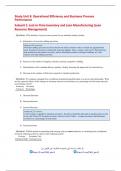Judgments
Study-Unit-8-Operational-Efficiency-And-Business-Process-Performance-Subunit-1-Just-In-Time-Inventory-And-Lean-Manufacturing-Lean-Resource-Managem.pdf
Study-Unit-8-Operational-Efficiency-And-Business-Process-Performance-Subunit-1-Just-In-Time-Inventory-And-Lean-Manufacturing-Lean-Resource-M
[Show more]



